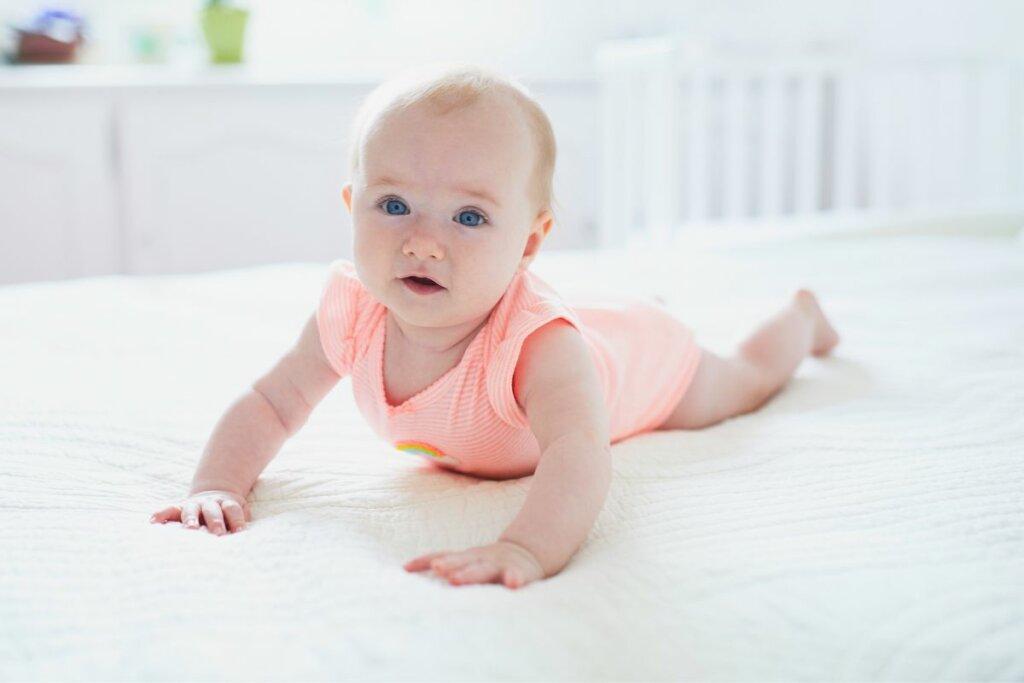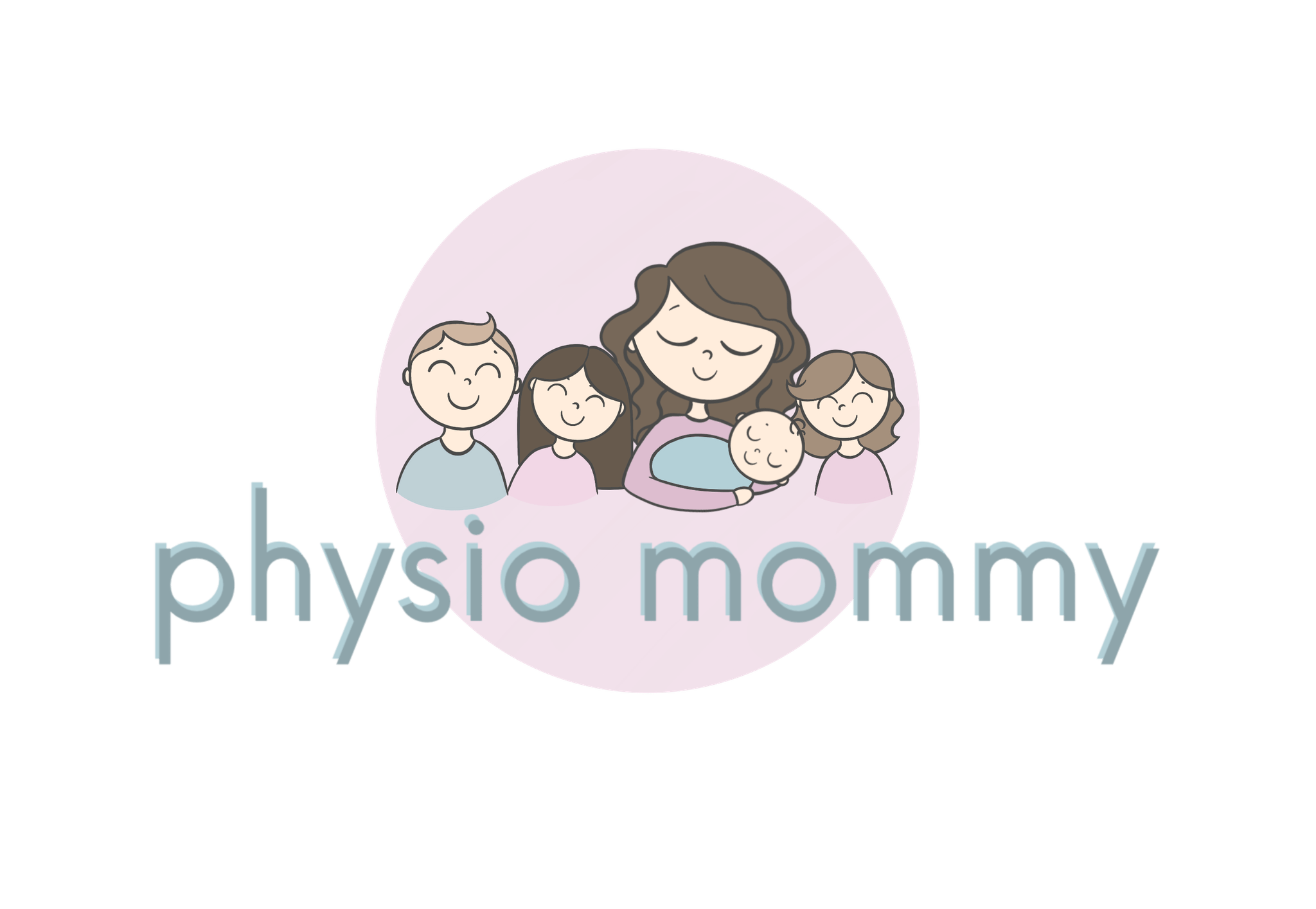Child development
from 4 – 7 month of life
As each child’s PACE OF DEVELOPMENT may be slightly different, be sure to learn about the DEVELOPMENTAL WINDOWS, i. e. TIME PERIODS in which a particular skill should appear.

WHEN ON THE BACK:
These next few months of life bring a lot of new things! The baby has already got symmetry under control, discovered the midline of the body and now feels much more stable – both in lying on the tummy as well as on the back. So right now, nothing stands in the way of “going further”!
The child begins to feel more confident in gaining new skills. He or she experiments with shifting the body weight to both sides – the side onto which the baby turns over gets elongated.
When lying on the back, the baby reaches his or her hands towards toys more freely and this movement no longer causes them to lose their balance. Less and less frequently, the baby reacts to a sudden change of the head position with the Moro reflex. The head can move freely to the left and right and these movements don’t cause the loss of stability in the torso anymore.
As time passes, the child notices their hands – he or she plays with them in the midline of the body, touches their knees… At the end of the 5th month of life, the baby is able to turn to the side – by bending the legs and shifting the body weight but without positioning the pelvis at an oblique angle (so-called “en block” rotations).
Over time, the child works on “dissociation”, i.e. positioning the hips obliquely to the shoulders. It is necessary for proper rotations and gaining other skills.

WHEN ON THE TUMMY:
The baby stays in the tummy position more and more willingly. Although the little one is not yet able to change this position on their own (if the baby runs out of patience, you will see it right away :)), he or she starts to experiment with shifting the body weight to both sides. While shifting it to the left, he or she elongates the left side of the body (the baby props on the left hand and the left leg is loosely straightened). The right leg tends to bend and the right hand (free of the body weight, which is now put on the left hand) can reach towards a toy. The end of the 6th month of life is all about propping up on straightened arms and raising the torso above the ground.
The second half of the first year of life is all about learning locomotion – from turning and belly crawling to the position on all fours and walking. By this time, the baby has already learned basically everything he or she needs for active position changes.
The little one can lie symmetrically, lift bent legs above the ground and draw the chin to the chest. He or she also freely turns the head from side to side… So now it’s time for rotation training!
Turning from the back to the belly is usually the first to appear. The movement begins with turning the head and the appropriate positioning of the hands. Then, the baby raises bent legs above the ground and shifts the body weight to the side to which he or she intends to turn. The child moves the pelvis to the oblique position. The leg that will be on the bottom straightens and the other one bends. The baby actively turns to the side and then to the tummy.
The baby willingly stays in the tummy position, which often leads to propping up on straightened arms. He or she is also able to rotate around the axis of the body and works on lying on the side.
At the end of the 6th month of life, the little one can put their toes in the mouth, which indicates that he or she is ready to “go further”. Around the 7th month, rotations from tummy to back appear. At first, they might be random but the baby quickly learns to control their body well enough to start rotating consciously.
Around 6th/7th month, the baby starts to crawl – at first backwards and then forwards.
What can we expect from a child between 4th and 7th month of life?
In lying on the back:
- the baby lies symmetrically, freely reaches their hands towards toys, turns head to both sides,
- is able to keep his or her eyes on an object and gets better at noticing objects which are placed in the midline of the body,
- begins to notice his or her hands and observes them with curiosity,
- assumes a reclining position – places their thighs at right angle to the torso and lower leg,
- lifts the legs above the ground, reaches their hands towards knees and turns to the sides – but without rotating shoulders and hips (so-called “en block rotation”),
- over time, moves the pelvis towards reaching the oblique position.
In lying on the belly:
- the child props up on straightened arms – hands become the base of support. Sometimes, while pushing off the ground, the baby moves backwards,
- at the end of 5th month of life, the so-called “swimming” appears – in that moment, the baby straightens the body to the maximum – he or she lifts the hands and straightened legs above the ground and starts to rock backwards and forwards or to the sides. The “swimming” should end with a symmetrical propping up on straightened arms,
- the little one begins to “pivot”, i.e. rotate around the axis of the body and starts to assume the side position,
- at the end of 6th month of life, the child masters the ability of propping up on straightened arms and actively lifts the torso above the ground,
- the baby starts to crawl – at first backwards and then forwards. Crawling should involve shifting the body weight alternatively to both sides.
What should raise a red flag?
- lack of symmetry of the torso and head,
- head tilted or constantly turned to one side, flattened,
- in lying on the tummy, if the baby strongly tilts the head backwards, lifts the bottom above the ground and cannot prop oneself up on the forearms,
- the child shifts the body weight incorrectly – for example, while shifting it to the left, shrinks the left side of the body at the same time and turns to the back again,
- the baby is not able to play with a toy in the midline of the body and his or her hands are still firmly clenched,
- in lying on the back, he or she doesn’t lift the bent legs above the ground or crosses them when they’re straightened,
- when it’s difficult to maintain eye contact with the baby
- the baby tenses up, arches backwards,
- there is a visible preference of one body side – the baby reaches towards toys usually with the same hand, turns the head to one side, the head isn’t straight but one ear is inclined more towards the shoulder, head flattening appears,
- the child crawls only on one side, is unable to shift the body weight alternatively to both sides,
- there is little activity against the force of gravity – the child is reluctant to reach out their hands in front of the body or lift bent legs above the ground.


